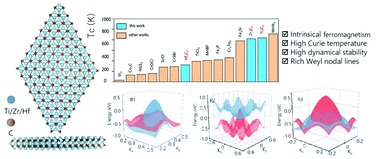Time-reversal-breaking Weyl nodal lines in two-dimensional A3C2 (A = Ti, Zr, and Hf) intrinsically ferromagnetic materials with high Curie temperature†
Abstract
Most materials that feature nontrivial band topology are spin-degenerate and three dimensional, strongly restricting them from application in spintronic nanodevices. Hence, two-dimensional (2D) intrinsically spin-polarized systems with rich topological elements are still in extreme scarcity. Here, 2D A3C2 (A = Ti, Zr, and Hf) materials with the P![[6 with combining macron]](https://www.rsc.org/images/entities/char_0036_0304.gif) m2 type structure are reported as new ferromagnetic materials with intrinsic magnetism and good stability. Unlike the Weyl nodal lines existing in nonmagnetic 2D systems, A3C2 hosts time-reversal-breaking Weyl nodal rings (two Γ-centered, one K-centered, and one K′-centered) without spin–orbit coupling (SOC). These nodal rings still remained under SOC with magnetization along the z direction (easy magnetization axis). More interestingly, the Curie temperatures (TC) of A3C2 were determined based on the Monte Carlo simulation. Ti3C2 features an extraordinary TC (above 800 K), and those of Zr3C2 and Hf3C2 are above room temperature. Therefore, A3C2 materials are excellent platforms to study magnetic Weyl nodal lines in high TC ferromagnetic 2D materials.
m2 type structure are reported as new ferromagnetic materials with intrinsic magnetism and good stability. Unlike the Weyl nodal lines existing in nonmagnetic 2D systems, A3C2 hosts time-reversal-breaking Weyl nodal rings (two Γ-centered, one K-centered, and one K′-centered) without spin–orbit coupling (SOC). These nodal rings still remained under SOC with magnetization along the z direction (easy magnetization axis). More interestingly, the Curie temperatures (TC) of A3C2 were determined based on the Monte Carlo simulation. Ti3C2 features an extraordinary TC (above 800 K), and those of Zr3C2 and Hf3C2 are above room temperature. Therefore, A3C2 materials are excellent platforms to study magnetic Weyl nodal lines in high TC ferromagnetic 2D materials.



 Please wait while we load your content...
Please wait while we load your content...